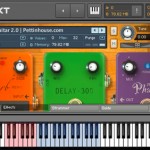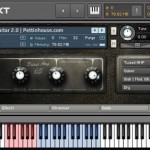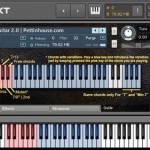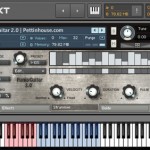When it comes to instruments, guitar is the instrument I can play the least. Everytime I get a producing job including guitar, I have to work my way around by using samples or hire a professional guitar player, so I was really excited about testing Funky Guitar 2.0 as it is supposed to deliver some realistic licks.
Content
For this library a Stratocaster has been sampled and squeezed into a 1,15 GB pack of samples. It runs with the full retail versions 3, 4 and 5 of KONTAKT and is easily available through the pettinhouse.com homepage via download (99 EUR / paypal & credit card accepted).
Graphic Interface
When opening the .nkm file for the first time, I thought I made a mistake. I downloaded more than 1 GB of samples and it would show only one file? This didn’t seem a lot, but after I took a closer look, I realized that what I thought was an installing mistake really was a very well thought through instrument using a clean surface with easy handling.
All the sounds are organized in this one Kontakt instrument. There are four good looking and self-explaining tabs to guide through the different sounds.
1.) Main 2.) Effects 3.) Strummer 4.) Guide
1.) Main
This tab features the basic functions you would expect from a guitar amp. On the right, you can choose from six amp simulations, choose to play the dry signal or activate the gainer & the wahwah (which is very well playable with the modulation wheel of your keyboard). On the left you have four knobs to adjust drive, bass, mid & treble.
2.) Effects
The multicolored tab features three effects: Reverb, Delay & Phase
3.) Strummer
This is the tab I spent most of my time with using this instrument. The main attraction here is the arpeggiator. You can set it to soft or hard, up or down strokes or soft or hard, up or down noise for each counting time. By setting these you can create your own rhythm or you can choose from 20 presets. There are a couple of knobs in this tab, to set the playing style & sustain of your various strokes.
4.) Guide
As I mentioned earlier, the whole surface is very self-explaining but if you still have problems this tab will help you with it. Everything you might want to know is explained in detail. Also you will find a picture of the key assignments on your keyboard.
Handling
While playing you can choose from a great pile of chords & variations (f.e. Min, Maj., Plucked, Free Chords, 7/9, Min7…) on the keys C0 to B0. Just hit them once and the specific chord is selected. Now you can go on and choose which chords you want to play and select them with your right hand from C1 to B2. The left hand can use the mod wheel to add wah-wah or slide the chord by pulling down the pitch wheel and quickly release it. This is a great feature, which helps to add realism to the sounds.
Sound
There is only one guitar, the Stratocaster, which was sampled. As this is “the” funk guitar (used by Hendrix and many more) there is no need for a further six-string. This guitar was sampled very well. All the sounds and all the slight differences between the different articulations blend really excellent. The different amps slightly differ from each other and sound decent. If you get tired of them, you can always switch to dry mode and use your favorite vst amp simulation. (I tried some metal amps on it, speeded up the tempo and came up with some very interesting not-funk-related results).
The only drawback is the static sound of the arpeggiator. When you program a song using a lot of funk guitar, after a while, the rhythm starts to sound too robotic (but maybe it is my programming mistake just due to the fact that I fail at playing a real guitar). I am missing a button to humanize the sound. You can select the amount of swing you add and it is very easy to adjust it to one of the knobs of the master-keyboard and tweak it while playing, still… it just doesn’t sound totally human. So if you want to play really dirty funk, you got to put in a lot of extra programming of your grooves after you recorded them. For pop-funk this doesn’t mind, in contrast it works really well.
The effects are a nice add-on, but it is not like you couldn’t go without them. I’d prefer the effects of Guitar Rig or IK Multimedia. Only exception is the wah effect, which works fantastic with the rhythms and is a lot of fun to play.
Usage
This library is mostly suited for funk music riffs. If you are looking for something else, this probably won’t be your product of preference. I am a huge fan of using stuff another way than it is supposed to and I tried a lot. With the right amp-simulation it is possible to use some of the grooves for great metal-riffs and also some more experimental sounds that merged perfectly with my electronic tracks, but you probably wouldn’t buy it just for this reason. Also I found it slightly more useful for Pop-Funk and Disco-Funk as for Northern Soul / Dirty Funk tracks.
Conclusion
This library is easier to handle as most other guitar libraries I used before, thanks to its excellent interface. After two minutes you will be able to set up realistic and usable rhythm guitar tracks.
If you are looking for an instrument that creates funk rhythms to fit in a low budget project where no guitar player is affordable or you want to create layouts for your guitarist (or for a customer), this should be your favorite weapon of choice.




